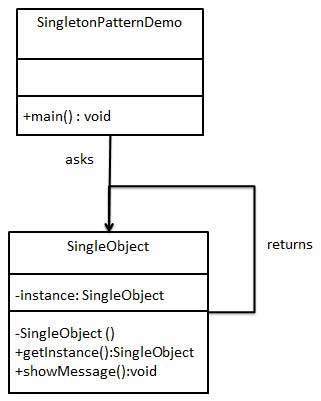- 设计模式-Singleton模式
- 设计模式-主页
- 设计模式-概述
- 设计模式-工厂模式
- 抽象工厂模式
- 设计模式-Singleton模式
- 设计模式-生成器模式
- 设计模式-原型模式
- 设计模式-适配器模式
- 设计模式-桥梁模式
- 设计模式-过滤器模式
- 设计图案-复合图案
- 设计图案-装饰图案
- 设计图案-立面图案
- 设计图案-飞线图案
- 设计模式-代理模式
- 责任链模式
- 设计模式-命令模式
- 设计模式-解释器模式
- 设计模式-迭代器模式
- 设计模式-中介模式
- 设计模式-Memento模式
- 设计模式-观察者模式
- 设计模式-状态模式
- 设计模式-空对象模式
- 设计模式-战略模式
- 设计模式-模板模式
- 设计模式-访客模式
- 设计模式-MVC模式
- 业务代表模式
- 复合实体模式
- 数据访问对象模式
- 前控制器模式
- 拦截过滤器模式
- 服务定位器模式
- Java传输对象模式
设计模式-Singleton模式
Singleton pattern is one of the simplest design patterns in Java. This type of design pattern comes under creational pattern as this pattern provides one of the best ways to create an object.
This pattern involves a single class which is responsible to create an object while making sure that only single object gets created. This class provides a way to access its only object which can be accessed directly without need to instantiate the object of the class.
Implementation
We're going to create a SingleObject class. SingleObject class have its constructor as private and have a static instance of itself.
SingleObject class provides a static method to get its static instance to outside world. SingletonPatternDemo, our demo class will use SingleObject class to get a SingleObject object.

Step 1
Create a Singleton Class.
SingleObject.java
public class SingleObject {
//create an object of SingleObject
private static SingleObject instance = new SingleObject();
//make the constructor private so that this class cannot be
//instantiated
private SingleObject(){}
//Get the only object available
public static SingleObject getInstance(){
return instance;
}
public void showMessage(){
System.out.println("Hello World!");
}
}
Step 2
Get the only object from the singleton class.
SingletonPatternDemo.java
public class SingletonPatternDemo {
public static void main(String[] args) {
//illegal construct
//Compile Time Error: The constructor SingleObject() is not visible
//SingleObject object = new SingleObject();
//Get the only object available
SingleObject object = SingleObject.getInstance();
//show the message
object.showMessage();
}
}
Step 3
Verify the output.
Hello World!